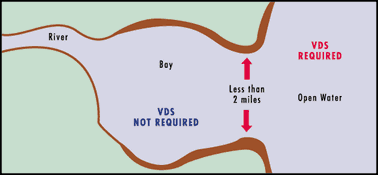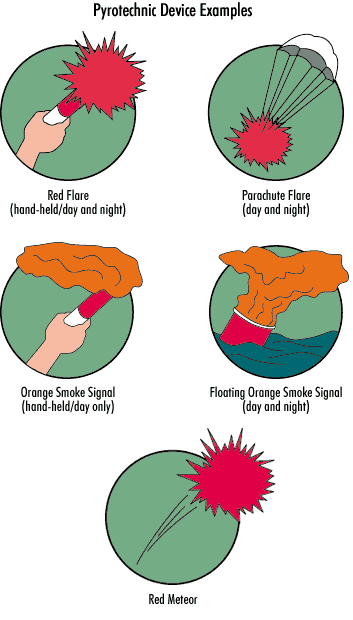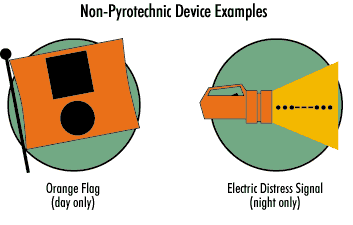
Visual Distress Signals
All vessels used on coastal waters, the Great Lakes, territorial seas, and those waters connected directly to them, up to a point where a body of water is less than two miles wide, must be equipped with USCG Approved visual distress signals. Vessels owned in the United States operating on the high seas must be equipped with USCG Approved visual distress signals.

The following vessels are not required to carry day signals but must
carry night signals when operating from sunset to sunrise:
Pyrotechnic Visual Distress Signals must be Coast Guard Approved,
in serviceable condition, and readily accessible.

Non-Pyrotechnic Devices
Non-Pyrotechnic Visual Distress Signals must be in serviceable condition, readily accessible, and certified by the manufacturer as complying with USCG requirements.
They include:
1. Orange distress flag
Day signal only. Must be at least 3 x 3 feet with a Black
Square and ball on an orange background. Must be marked with an indication
that it meets Coast Guard requirements in 46 CFR 160.072. Most distinctive
when attached and waved on a paddle, boathook, or flown from a mast. May
also be incorporated as part of devices designed to attract attention in
an emergency, such as balloons, kites, or floating streamers.
2. Electric distress light. Accepted for night use only Automatically flashes the international SOS distress signal (... --- ...) Must be marked with an indication that it meets Coast Guard requirements in 46 CFR 161.013.

Under Inland Navigation Rules, a high intensity white light flashing at regular intervals from 50-70 times per minute is considered a distress signal. Such devices do NOT count toward meeting the visual distress signal requirement, however.
Regulations prohibit display of visual distress signals on the water under any circumstances except when assistance is required to prevent immediate or potential danger to persons on board a vessel.
All distress signals have distinct advantages and disadvantages. No single device is ideal under all conditions or suitable for all purposes. Pyrotechnics are universally recognized as excellent distress signals. However, there is potential for injury and property damage if not properly handled. These devices produce a very hot flame and the residue can cause burns and ignite flammable materials.
Pistol launched and hand-held parachute flares and meteors have many characteristics of a firearm and must be handled with caution. In some states they are considered a firearm and prohibited from use.
The following are just a few of the variety and combination of devices, which can be carried in order to meet the requirements:
2-Meter
Half Square I build Antenna part II
My Link to Ham'er and the world
Maps and my QTH
My life in pictures Second Link page Navigation rules Personal Floatation Device
Latitude Longitude & Bearing US State & Cities HF Loop antenna